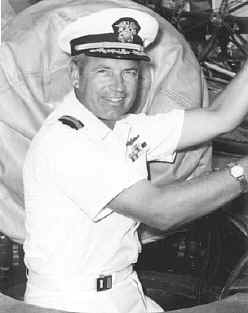At the January meeting of SUBVETs, Triton Base, member Jim Newman (of the Tilefish) mentioned that a former officer of the Cavalla lived right here in Houston. I soon contacted Zeb Alford and he was willing to meet for an interview. On an overcast Thursday evening we met beside the gorgeous lake next to his home. Zeb Alford looked like a submarine captain. He could have been cast for the part in a movie and fit right in. We made ourselves comfortable on a bench near the water. While we talked, a certain black swan, whose mate was attending to their eggs, drew near the bench. Capt. Zeb explained that he and the ebony drake were old antagonists, in a friendly sort of way, and the male was intent on guarding his territory and dissuading possible adversaries. The drake watch Alford closely, and when man let his guard down, the swan would snap at his trousers. Alford would grin and berate his adversary, then continue nonplused.
The Cavalla "When I came aboard Cavalla, she was part of SUBDEVGRU 2 (Submarine Development Group Two). They had changed her up a lot, adding all the new sonar, passive sonar, not active, to her bow. She had top two torpedoes removed and one of her engines, to make room for the extra gear. We put out to sea a lot in those days, trying new tactics, and taking part in exercises. The old K-class submarines were often working with us. The Cavalla had a flashing light affixed to her snorkel mast, a strobe light. When the Cavalla had detected a target, she would turn on the light and radio a code. Carrier planes would take off and find this signal. Then Cavalla would vector the planes toward the target. With the sonar gear and by making use of convergence zones, Cavalla was able to detect targets from a long way out. The only problem was that she didn't have any "legs"; she couldn't close with any speed and remain silent and submerged. So she would detect, and supporting air power would attack. When we developed the quiet nuclear subs, then we could detect and attack."
The Men "All of the commanders from the war that I had contact with were very friendly, supportive men. When (Gene) Fluckey finished his book (Thunder Below), he used the proceeds to rent a river boat and throw a party for the other men in his department."
 Study
Time "The diesel boats were no where nearly as
technically complex as the new nuclear subs. We had to find a way to write operating manuals
so they could be understood by a regular crew. Most of the officers had the algebra and trig
down cold, but most of the enlisted men came into the Navy right from high school. But as
submariners they had a lot of responsibility--every man on a sub depends on the next. We
found that a lot of the crew would enroll in higher educational correspondence classes--there's
a lot of time on your hands aboard a modern submarine--and the college men would help the
students with their studies. I found the men to be exceptionally willing to increase their
knowledge."
Study
Time "The diesel boats were no where nearly as
technically complex as the new nuclear subs. We had to find a way to write operating manuals
so they could be understood by a regular crew. Most of the officers had the algebra and trig
down cold, but most of the enlisted men came into the Navy right from high school. But as
submariners they had a lot of responsibility--every man on a sub depends on the next. We
found that a lot of the crew would enroll in higher educational correspondence classes--there's
a lot of time on your hands aboard a modern submarine--and the college men would help the
students with their studies. I found the men to be exceptionally willing to increase their
knowledge."
Captain of the USS Shark " The Shark was one of our fastest submarines. We would be assigned to detect and track the Soviet subs as they left their ports. Back then it wasn't a difficult task--the Russian subs sounded like threshing machines, they made so much noise. I understand their newer subs are much quieter, but we still have a substantial lead on them. Stealth is everything in submarines. If you can't hear it, you don't know it's there."
During our meeting, the black swan slowly circled in the water next to our bench, closing surreptitiously ever so often to try and obtain a "shooting solution". Capt. Zeb would sense the approach and shift his position to "evade". This contest struck me as intriguing, as if it was a flashback to the hide-and-seek games played out in the ocean's depths when the man across from me commanded the most powerful weapon of its time. The swan never once approached me. I wasn't surprised.
March 27,1997
Return to Cavalla Crews